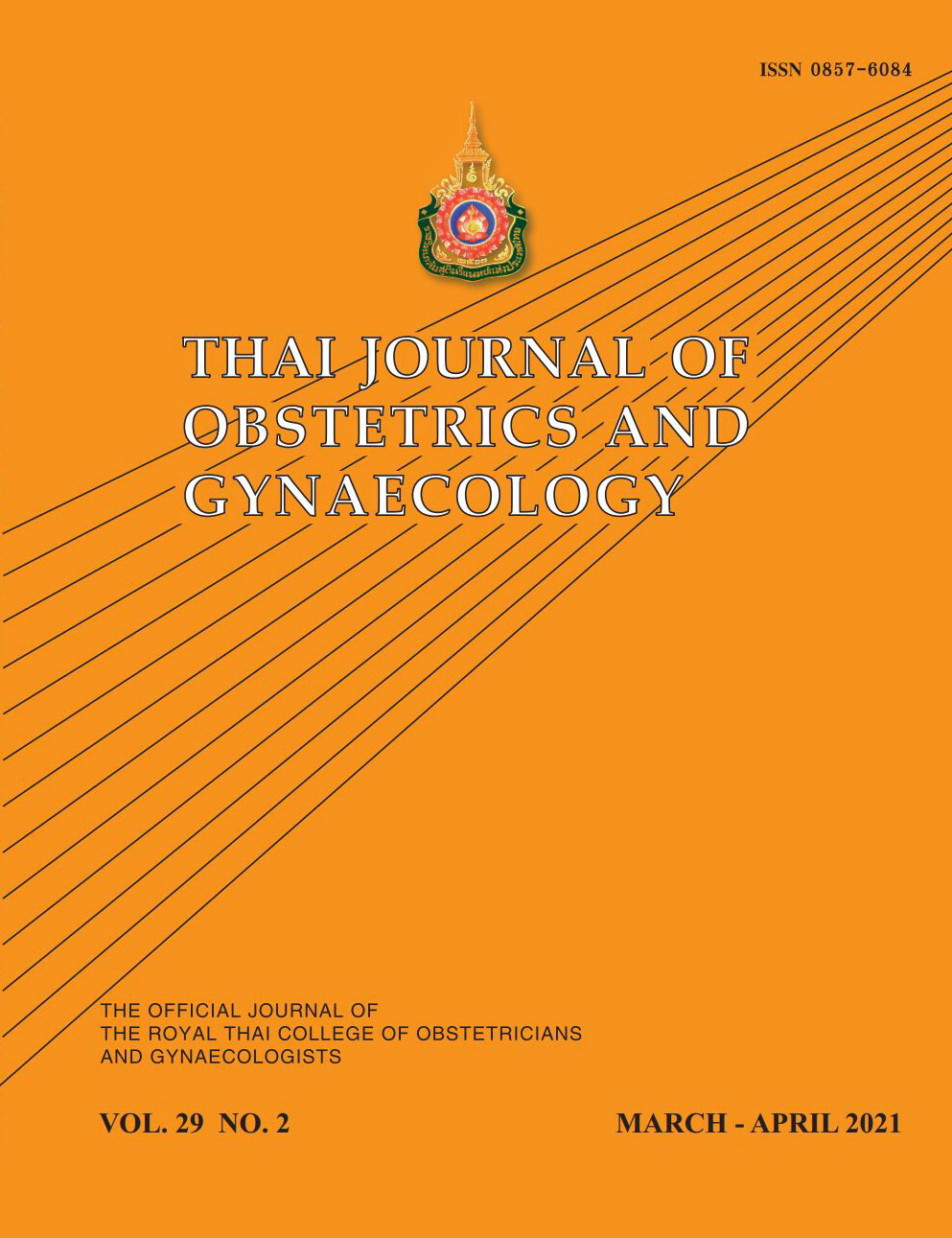Transvaginal Ultrasound Measurement of the Uterocervical Angle for Prediction of Spontaneous Preterm Birth
Main Article Content
Abstract
Objective: To determine the predictive values for spontaneous preterm birth by using transvaginal ultrasonography of the uterocervical angle (UCA) in pregnant women with 16-24 weeks’ gestation
Material and Methods: A prospective cohort study was conducted in singleton pregnant women with 16-24 weeks’ gestation. The UCA was performed at the time of cervical length screening. The data were recorded. Then the predictive values for spontaneous preterm birth were calculated.
Results: The data from 528 pregnant women was analyzed. Fifty-nine women developed spontaneous preterm birth and seven of these developed preterm birth at < 34 weeks. The UCA was significantly wider in preterm group when compare with controls (102.8 degrees vs 88.7 degrees, P<0.001). The sensitivity, specificity, positive predictive value and negative predictive values of the UCA more than 95 degrees for prediction of spontaneous preterm birth were 74.6%, 64.6%, 21.0% and 95.3% respectively.
Conclusion: A wide uterocervical angle > 95 degrees detected during the second trimester was associated with an increased risk for spontaneous preterm birth < 37 weeks. This data showed that the uterocervical angle may be used as a screening tool for spontaneous preterm birth.
Article Details
References
2. Beck S, Wojdyla D, Say L, Betran AP, Merialdi M, Requejo JH, et al. The worldwide incidence of preterm birth: a systematic review of maternal mortality and morbidity. Bull World Health Organ 2010;88:31-8.
3. Arias F, Bhide A, Arulkumaran S, Damania K, Daftary S. Arias practical guide to high-risk pregnancy and deliver: a south asian perspective. 4th ed. New Delhi: Elsevier India 2015: 135.
4. Hack M, Taylor HG, Klein N, Eiben R, Schatschneider C, Mercuri-Minich N. School age outcomes in children with birth weights under 750 g. N Engl J Med 1994;331:753-9.
5. Travers CP, Carlo WA, Mcdonald SA, Das A, Bell EF, Ambalavanan N, et al. Mortality and pulmonary outcomes of extremely preterm infants exposed to antenatal corticosteroids. Am J Obstet Gynecol 2018;218:130.e1-13.
6. World Health Organization [Internet]. 2012. Born too soon: the global action report on preterm birth[cited 2019 Jan 11]. Available from: https://www.who.int/pmnch/media/news/2012/201204_borntoosoon-report.pdf
7. Suhag A, Berghella V. Short cervical length dilemma. Obstet Gynecol Clin North Am 2015;42:241–54.
8. Berghella V, Blackwell S, Anderson B, Chauhan SP, Copel J, Gyamfi C, et al. Progesterone and preterm birth prevention: translating clinical trials data into clinical practice. Am J Obstet Gynecol 2012;206:376–86.
9. American College of Obstetricians and Gynecologists. ACOG Practice Bulletin No. 130: Prediction and prevention of preterm birth. Obstet Gynecol 2012;120:964-73.
10. Celik E, To M, Gajewska K, Smith GC. Cervical length and obstetric history predict spontaneous preterm birth: development and validation of a model to provide individualized risk assessment. Ultrasound Obstet Gynecol 2008;31:549–54.
11. Son M, Grobman WA, Ayala NK, Miller ES. A universal mid-trimester transvaginal cervical length screening program and its associated reduced preterm birth rate. Am J Obstet Gynecol 2016;214:365.e1-5.
12. Miller ES, Tita AT, Grobman WA. Second-trimester cervical length screening among asymptomatic women: an evaluation of risk-based strategies. Obstet Gynecol 2015;126:61-6.
13. Werner EF, Hamel MS, Orzechowski K, Berghella V, Thung SF: Cost-effectiveness of transvaginal ultrasound cervical length screening in singletons without a prior preterm birth: an update. Am J Obstet Gynecol. 2015;213:554.e1–554.e6.
14. Dziadosz M, Bennett TA, Dolin C, West Honart A, Pham A, Lee SS, et al. Uterocervical angle: a novel ultrasound screening tool to predict spontaneous preterm birth. Am J Obstet Gynecol 2016;215:376.e1-7.
15. Sochacki-Wójcicka N, Wojcicki J, Bomba-Opon D, Wielgos M. Anterior cervical angle as a new biophysical ultrasound marker for prediction of spontaneous preterm birth. Ultrasound Obstet Gynecol 2015;46:377–8.
16. Sepúlveda-Martínez A, Díaz F, Muñoz H, Valdés E, Parra-Cordero M. Second trimester anterior cervical angle in a low-risk population as a marker for spontaneous preterm delivery. Fetal Diagn Ther 2017;41:220–5.
17. Cannie MM, Dobrescu O, Gucciardo L, Strizek B, Ziane S, Sakkas E, et al. Arabin cervical pessary in women at high risk of preterm birth: a magnetic resonance imaging observational follow-up study. Ultrasound Obstet Gynecol 2013;42:426–33.
18. Saccone G, Maruotti GM, Giudicepietro A, Martinelli P. Effect of cervical pessary on spontaneous preterm birth in women with singleton pregnancies and short cervical length: a randomized clinical trial. JAMA 2017;318:2317-24.
19. FarràsLlobet A, Regincós Martí L, Higueras T, Calero Fernández IZ, Gascón Portalés A, Goya Canino MM. et al. The uterocervical angle and its relationship with preterm birth. J Matern Fetal Neonatal Med 2018;31:1881-84.


